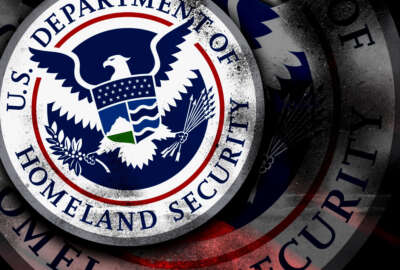
DHS S&T cyber division hitting its stride with research transition, start-up projects
The Homeland Security Department Science and Technology Directorate's cybersecurity division is in a more comfortable place now with many of its top research and...
As an incubator of new ideas, the cybersecurity division of the Homeland Security Department’s Science and Technology Directorate is finding a comfortable place in the Trump administration’s new priorities.
It’s contributing to the administration’s research as it develops Cyber.gov, a repository of next-generation tools and ideas for securing federal networks.
“Can we define an architecture, add new capability into that architecture and then deploy it out with departments and agencies?” Doug Maughan, director of the DHS Science and Technology Directorate’s cybersecurity division (CSD), said in an interview with Federal News Radio at the division’s Research and Development Showcase and Technical Workshop in Washington. “We’re in the early stages. We’re doing it in partnership with other departments and agencies and in DHS.”
The agencies plan to send out the first round of documents on Cyber.gov for public comment in the next month.
It’s one of several ways CSD is contributing to the administration’s recent cybersecurity executive order, which the president signed in May.
“We are working with the administration, looking at new technologies that can be brought in as part of the executive order to improve the security of dot gov,” Maughan said.
Some of those technologies come from the more than 75 successful transitions to practice that CSD has facilitated within the past 13 years.
“Transition is what we build everything around,” Maughan said. “If we’re funding research, the goal is to transition it, commercialize it, not wanting research to be funded and just put on a shelf. We built our program around that so that when we fund research, we fund the transition as well. It’s part of the project. We make sure that we have customers who are going to be consumers of the technology.”
For example, CSD recently funded an automotive forensics project with a small company. Its creating a tool that pools data from more than 6,700 car models that law enforcement officers can use to learn more about specific crimes. Law enforcement channels in more than 15 countries are using the tool, Maughan said.
In addition, the division recently published a broad agency announcement explaining its plans for communicating with international partners. It’s another key aspect of the president’s cyber EO.
CSD recently held its first R&D call with the Netherlands.
“The idea is teams have to be at least one U.S. and one Dutch participant,” Maughan said. “They can be universities, companies, national labs from our side. For them, it’s a university or company; they don’t have any labs. They do a joint proposal, we do reviews, we make decisions, we move forward, contract and then it’s a joint project from then on.”
Other countries, including the United Kingdom, Singapore and Israel, are also interested.
“It came about, because in talking to our international partners, they wanted to work with us,” Maughan said. “In the past, they have, but their money has been spent with U.S. researchers. They wanted their money spent with researchers in their country. We worked with our lawyers and our contracting folks to build a process that allows us to now do that with our international partners.”
As CSD and S&T continue to transition more research and projects to practice, the directorate is bracing for budget cuts.
The president’s budget request proposed a $144 million cut to DHS S&T in fiscal 2018.
There will be impacts to CSD’s work, Maughan acknowledged, since many projects are start-up contracts that last more than one year at a time.
“Research programs don’t always just end,” he said. “There are multiple year projects, so how do I balance cuts with those areas that might be cut? How I keep as many boats afloat as possible? We’ll wait and see how the budget process plays out.”
Silicon Valley
Now more than a year old, DHS’ Silicon Valley Innovation Program, the S&T Directorate has been traveling across the country and the world to explain how the agency is funding young companies.
“What we’ve learned is that the start-up companies don’t actually know what DHS does,” Maughan said.
DHS S&T funds companies in four phases. Each phase is no more than six months, and companies receive a maximum of $200,000 for each phase. DHS and the company can choose to walk away at any phase if either decide the agreement isn’t in their best interest.
DHS makes a decision about whether it chooses to fund a company on the same day that it hears a short in-person or web presentation from the start-up.
The division is also using other transaction authorities as a contracting vehicle. The average contracting time takes about 30 days, Maughan said, though the fastest process took 10 days.
So far, DHS S&T has received more than 140 applications from start-ups and awarded 20 contracts.
“We are just getting into phase two and phase three projects, where they’re doing pilots with their operational components,” Maughan said. “We’re seeing some real value to folks like the Customs and Border Protection, where in the past, they’ve never worked with start up companies, they’ve never really had access to innovative companies like that.”
Working with start-up companies still relatively young in their development and new to the government space can be risky, but the division is learning how to address and reduce that uncertainty.
The agency took three companies to the San Diego border to show them the environment and the technology that agents currently use.
Maughan said that experience is helpful, because many start-ups or research companies develop new technology in their garage or a lab , not the border.
“We have, for example, border patrol agents on our review teams with the startup company,” he said. “If we’re going to make an investment in a company and in a technology, we’re making it because the border patrol agents reviewed the proposal, were in on the discussion and said, ‘If that technology was developed, we would operationalize it and put it into the field.’ That reduces our risk a lot. We’re not just funding things without a customer.”
Copyright © 2025 Federal News Network. All rights reserved. This website is not intended for users located within the European Economic Area.
Nicole Ogrysko is a reporter for Federal News Network focusing on the federal workforce and federal pay and benefits.
Follow @nogryskoWFED
Related Stories




